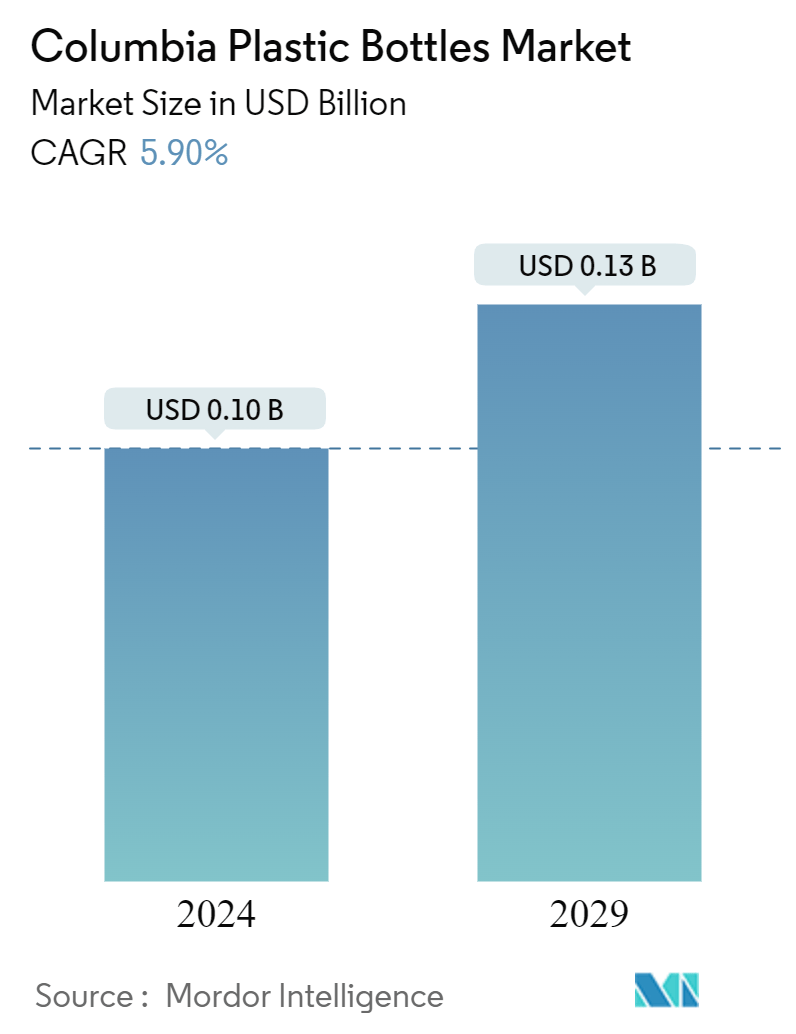Market Size of Columbia Plastic Bottles Industry

| Study Period | 2019 - 2029 |
| Base Year For Estimation | 2023 |
| Market Size (2024) | USD 0.1 Billion |
| Market Size (2029) | USD 0.13 Billion |
| CAGR (2024 - 2029) | 5.90 % |
| Market Concentration | High |
Major Players.webp)
*Disclaimer: Major Players sorted in no particular order |
Columbia Plastic Bottles Market Analysis
The Columbia Plastic Bottles Market size is estimated at USD 0.10 billion in 2024, and is expected to reach USD 0.13 billion by 2029, growing at a CAGR of 5.90% during the forecast period (2024-2029). In terms of production volume, the market is expected to grow from 101.91 million tonnes in 2024 to 132.47 million tonnes by 2029, at a CAGR of 5.39% during the forecast period (2024-2029).
- Plastic bottles and containers, primarily composed of polyethylene terephthalate, polypropylene, and polyethylene, are widely used due to their lightweight properties and recyclability. These characteristics make plastic the preferred choice for end users in various industries, including food and beverage, personal care, and household products. The increasing global consumption of packaged and processed foods and the growing demand for bottled drinks are expected to drive market growth. The versatility of plastic packaging, its ability to extend product shelf life, and its convenience for consumers further contribute to its widespread adoption.
- Plastic packaging has gained popularity among Colombian consumers due to its lightweight and durable nature, enhancing ease of handling and transportation. Manufacturers prefer plastic packaging for its lower production costs and design versatility. The introduction of advanced polymers like polyethylene terephthalate (PET) and high-density polyethylene (HDPE) has expanded applications for plastic bottles across food and beverage, personal care, and household product industries. The market has experienced increased demand for PET bottles, driven by their recyclability, clarity, and barrier properties. This trend is supported by growing consumer awareness of environmental issues and a subsequent rise in demand for sustainable packaging solutions.
- The beverage segment of the Colombian plastic bottles market is expected to grow significantly due to increasing demand for bottled water and non-alcoholic beverages. This expansion is driven by several factors, including consumers' increasing preference for high-quality drinking water, heightened concerns about waterborne diseases from tap water, and bottled water's inherent convenience and portability. As consumers become more health-conscious and seek safer drinking options, bottled water demand will likely surge. The adaptability of plastic bottles to various beverage types and sizes enhances their popularity in the non-alcoholic beverages industry. This trend is expected to continue, potentially leading to increased investments in plastic bottle manufacturing and recycling infrastructure to meet the rising market demand.
- Colombia has implemented two significant regulations affecting the plastic industry: a tax on plastics and the progressive elimination of single-use plastics from the market. These regulations aim to reduce plastic waste and promote environmental sustainability. The plastic tax imposes additional costs on manufacturers and consumers, potentially influencing purchasing decisions. The gradual phase-out of single-use plastics targets items such as straws, cutlery, and specific packaging materials, forcing businesses to adapt their product offerings.
- While these regulations may constrain the traditional plastic bottle market, they also create opportunities for innovation in the industry. Companies are now incentivized to develop and produce alternative recyclable plastic materials that comply with the new regulations. This shift is likely to stimulate increased research and development efforts in sustainable packaging solutions, potentially leading to the emergence of new eco-friendly technologies and materials in the Colombian market.
- For instance, in December 2023, Postobón and Enka entered a ten-year agreement to advance PET recycling and circular economy initiatives in Colombia. Under this partnership, Enka will supply Postobón with EKO®PET resin, a food-grade material manufactured from post-consumer PET bottles. This resin has received approval from INVIMA and the FDA for food contact applications. The agreement aligns with Postobón's goal to incorporate 50% recycled raw material in its PET bottles by 2030. Additionally, Postobón supports the recycling sector through inclusive social programs like FARO Postobón (Strengthening Associations of Recyclers), which provides comprehensive assistance to over 6,000 recyclers.

